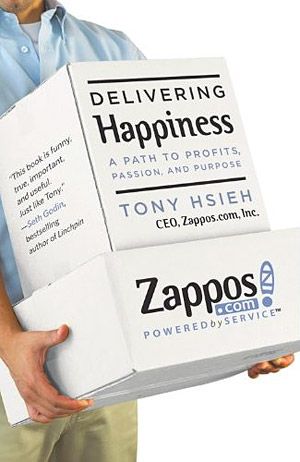I just finished Tony Hsieh’s book, Delivering Happiness, which is an autobiography of his tech journey from Illinois to the acquisition of Zappos by Amazon. As an avid reader of tech non-fiction, I can’t get enough startup stories behind the story. It’s great to get away from the sterile founding stories that go from idea to success with no interruption. The real stories are always messier, a lot less certain of themselves, and much more interesting.
Tony’s book was a little off the beaten path for me since I was neither a customer of Zappos nor someone who followed his career. The narrative was written in an informal style that at times bordered on campy. Just when I thought I had enough of Tony’s writing style though, he’d make me laugh out loud or provide some interesting insight and I’d feel the need to keep reading.
The short summary of the book is as follows: Tony was born in Illinois to Taiwanese-born parents, went to Harvard for computer science, and from an early age always had a leaning toward being an entrepreneur. After college he decided he didn’t want a real job at Oracle and found himself co-founder of Link Exchange, which was sort of the Google Adwords of the early web. After an acquisition by Microsoft for $265M, Tony wandered for a few years doing venture investments, running an incubator, working hard to lose his newfound wealth, and trying to create a Dotcom Baby commune in San Francisco. Zappos was one of Tony’s early investments, and after the fallout of the Dotcom Bust, he and his business partner decided to go all in on the investment by joining the company. After years of struggle and tough decisions, the company found product market fit and started its meteoric rise to be one of the most successful e-commerce companies of its time.
So what are the lessons I took away from the book:
Take Calculated Risks
Every entrepreneurial story has that moment where he or she takes the plunge. In Tony’s case, he had been engaged with Zappos as an investor, and gradually got closer to the company as his Dotcom wealth eroded around him. He eventually decided to take the CEO role of the fledgling company, and within a couple years had sold off all his investments to put everything in the company.
The successful entrepreneurs share one common trait when it comes to taking the entrepreneurial plunge: they almost never view what they are doing as a risk. They typically have analyzed and managed most of the downside risks of their venture, and view their move as calculated.
Agility Makes Up For Mistakes
After achieving early product market fit, Zappos struggled with its distribution and made a near fatal decision to outsource its warehouses to a Kentucky-based company located near the UPS worldwide hub. Within weeks, the inventory started piling up on the loading dock and customers began complaining about late deliveries. The team quickly responded and through heroics, managed to navigate the storm and transition the business back to Zappos-managed distribution.
Mistakes will be made in any early business. You can’t avoid making mistakes, but you can ensure you adapt quickly when you do. Agility in an organization will go a long way toward compensating for the certain mistakes.
Make the Tough Call
After achieving product market fit with Zappos and starting up the growth curve, Tony and team realized that building a call center in San Francisco was extremely hard. Most people viewed the job at Zappos as a transition job instead of a long term career. Since talent acquisition and management represented a substantial risk to the business, the executive team made the tough call of picking up and moving the business to Las Vegas. I’m not sure there are many harder calls than that one, which almost feels like a Solomon splitting the baby decision. But in the end the decision paid off with dividends as Zappos became a fixture in the Las Vegas tech scene, and the talent pool supported their rapid growth.
Last Thoughts
Ill confess that my favorite part of Delivering Happiness was not Tony's story at all, but the reference to the Jeff Bezos video on the acquisition of Zappos by Amazon. The video shows Jeff sitting in front of a flip chart discussing “everything he knows”, which can be summarized as: obsess over customers, invent on behalf of customers, think long term, and it’s always day 1.
But overall Tony’s book made for an interesting read on a highly successful company that is mostly forgotten in our world of tech bubble giants. It is also a much needed reminder that companies do not have to build cut throat, Uber-like cultures in order to achieve success.
